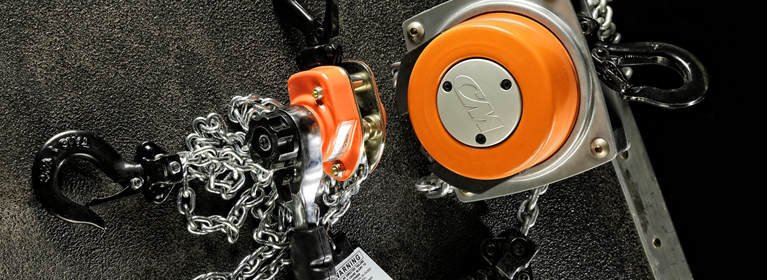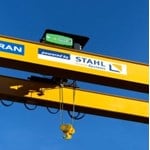
Factors to Consider When Selecting a Hoist
A Guide to Specifying the Right Hoist for Your Application
Hoisting & Lifting | How To's | by | 17 Feb 2020
Purchasing or specifying hoists to lift heavy objects in close proximity to equipment and/or personnel is a decision that deserves thoughtful consideration. In this article, we will identify some important items to factor into your decision-making process.
Download a complete guide to selecting the right hoist for your application.
Determining Required Capacity
When selecting a manual hand chain hoist, the rated capacity should be at least as high as the weight of the heaviest load to be lifted and no higher than the rated capacity of the pad eye, monorail system or other overhead structure from which the hoist will be suspended.
In addition to the factors listed above for manual hoists, when determining the capacity requirement for an electric or pneumatic hoist we must not only consider the weight of the heaviest load to be lifted, but we must also determine the Mean Effective Load ( MEL) and apply the MEL factor of .65.
For more detail refer to ASME HST-1, Performance Standard for Electric Chain Hoists, Section 1-1.1 through Section 1-2.4.2
Selecting a Suspension Type
Chain hoists can be suspended in a fixed location or they can be trolley mounted by means of a top hook or mounting lug. Trolleys can be rigid or articulating. Trolley traverse can be plain (push type), hand geared or motor-driven. See below for examples of typical chain hoist suspension types.
Choosing Lift, Reach & Headroom
It’s appropriate to group these three parameters together because they are closely related. Simply put, the length of lift is the distance the load hook can travel between its fully lowered and fully raised positions.
Reach is equal to the difference in elevation between the hoist suspension point (pad eye or trolley beam running surface) and the hook saddle in its lowest position.
Headroom is the distance from the hoist suspension point and the fully raised hook saddle. For a hoist with top-hook suspension, the headroom dimension is the distance between the saddle of the top hook and the saddle of the fully raised lower hook.
Understanding the Operation Type Needed for Your Application
Operation type refers to the power source used to drive the hoisting motion. Operation types include manual, electric or pneumatic (air) power. Some of the criteria for determining which of these types are best for a given application include initial cost, availability of utilities, duty cycle, lifting speed requirement, operating environment and more.
Manual hand chain hoists have the lowest purchase price, making them ideal for applications involving temporary or infrequent use, low capacities, short lift height and when power sources are not available.
Electric and pneumatic hoists offer faster lifting speeds, are more ergonomic and are better suited than manual hoists for heavy-duty cycles, high capacities and long lifts.
Air hoists require a substantial volume of compressed air for operation and are often used for applications involving long lifts or high duty cycles and in areas where electric power is impractical or unavailable. Air motors tend to be self-cooling, providing nearly unlimited run time capability. And, because there is no risk of electrical arcing, air hoists are also used in some hazardous areas where flammable gases or dust may be present. One downside is that air hoists tend to be significantly louder to operate than electric or manual hoists.
Electric hoists can have a lower purchase price than pneumatic hoists. They do not require the purchase and installation of an air compressor and are normally quieter than air hoists to operate. If suitable electric power is available, electric hoists are selected more often than pneumatic for most general lifting applications. Electric hoists can also be equipped with special motors and controls to make them suitable for use in designated hazardous areas.
Determining Required Duty Class
The American Society of Engineers (ASME) and The Hoist Manufacturer’s Institute (HMI) have developed and published standards for hoists, including hoist duty ratings. These duty classifications are based on numerous factors, including the number of lifts performed per hour over a given work period, the average and maximum load that is lifted, the frequency at which the maximum load is lifted, the average distance the load is raised and lowered, and the maximum number of stops and starts per hour. The table shown below is provided for reference to help you understand the significance of duty class ratings provided by the hoist manufacturer for their products.
Picking Your Lifting Speed
Hoist lifting speeds vary widely and should be considered carefully before making a selection. Generally speaking, faster lifting speeds are preferred for long lifts or for shorter lift applications in which a high number of lifting/lowering cycles must be completed in a relatively short period of time.
The weight of the load to be lifted, along with the required lifting speed and hoist gear ratio, determines the torque requirement, which in turn dictates the motor horsepower required to provide that torque. Higher horsepower motors can add to the size, weight and power consumption of a hoist, as well as its cost.
The most common lifting speeds are between 8 and 32 FPM. CMCO offers powered hoists with speeds as low as 3 FPM and as high as 64 FPM.
Determining a Power Supply
Some electric hoists are designed to operate on either 120 or 230vac, single-phase power. These hoists are typically ¼ to 2-ton capacity and are most often used in home workshops, garages, and some light manufacturing facilities. Most industrial facilities throughout North America are wired for 208, 230, 460 or 575v, 3-phase, 60 Hz power. The most common are voltages are 240v and 480v, although 575v is also frequently used in Canada. It is important to verify your available power supply before attempting to purchase or specify an electric hoist.
Selecting a Control Type for Your Electric Hoist
To reduce the risk of serious injury due to electric shock, most electric hoist controls do not run on the full line voltage that is supplied to the hoist motors. Instead, they utilize transformers to step down the control voltage to 120v or 24v. The majority of hoists in the U.S. feature 120v controls.
Hoists can be equipped with a variety of different control types. The most common are single-speed or two-speed contactor controls. Two-speed contactor control also requires a special motor with two-speed windings.
Another available control type is the variable speed drive (VFD), sometimes also referred to as an adjustable frequency drive (AFD). This solid-state control system adjusts AC motor speed and torque by varying motor input frequency and voltage. For example, a variable speed hoist that runs at 20 FPM on 60 Hz power would operate at roughly 10 FPM if through a VFD control the frequency is reduced to 30 Hz.
Closed-loop variable frequency drive systems, also known as flux vector drives, take VFD control to another level, using an encoder on rotating components, such as hoist motor shaft or gearbox output shaft, to send feedback to the control module. This type of closed-loop control system can provide extremely accurate speed control and load spotting and can be used in conjunction with a programmable logic control (PLC) to automate the lifting and lowering functions based on preset parameters. Another significant advantage of a flux vector hoist drive is dynamic braking, which provides softer stops and can significantly extend the life of the motor brake.
Choosing a Control Pendant
The majority of electric chain hoists come equipped with a hard-wired control pendant that is suspended from the hoist, trolley or crane (where applicable). In some cases, hard-wired pendant stations may also be wall-mounted. Wireless radio remote control systems are also available and can allow the operator to control hoist functions from anywhere within the general vicinity of the hoist. Radio control pendants can also be smaller, lighter weight and more ergonomic than a hard-wired pendant.
Download a complete guide to selecting the right hoist for your application.
Understanding Dimensional Constraints
Before selecting a hoist, it is important to consider any dimensional constraints that exist in the area where the hoist may be used. Issues such as headroom clearance, side clearance along the length of monorail or crane beam, and end approach are particularly critical clearances.
The term “end approach” (see dimension “A” to the right) can be defined as the distance between the centerline of the lifting hook and the end of a monorail beam, bridge beam or runway on which the hoist is operating.
This is important as it relates to the ability to center the hoist over the load to be lifted to avoid side pulling. Learn more about the dangers of side pulling.
Determining Needs for Special Environments
Standard chain hoists are designed for “normal operating conditions.” Conditions such as temperature extremes, unprotected outdoor areas, salt-laden marine environments, corrosive atmospheres, classified hazardous areas, clean rooms, and wash-down areas, among others, may require hoists with special modifications or optional features that are designed for those locations.
We hope the information in this article provided insight into some of the considerations that should be taken before buying or specifying a hoist. Selecting the right hoist for the application can be the first step towards safe, efficient and ergonomic movement of materials. For further assistance with your overhead lifting requirements, please contact our application experts.
Related Articles
Crane and Hoist Safety: The Dangers of Side Pulling
Staying Safe in Overhead Lifting Applications
This blog covers crane and hoist safety practices and addresses the dangers of side pulling and how to avoid it.
How to Conduct Hoist Pre-Operational Safety Inspections
A Guide to Hoist Inspections
Proper and routine hoist inspections are vital to ensuring safety and compliance during your lifting application.
Variable frequency drives, or VFDs, are a type of AC motor controller that drive an electric motor by varying the frequency and voltage supplied to it.

 United Kingdom - EN
United Kingdom - EN











